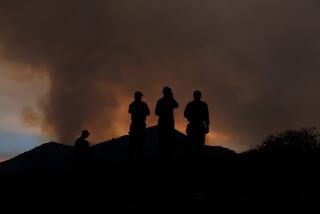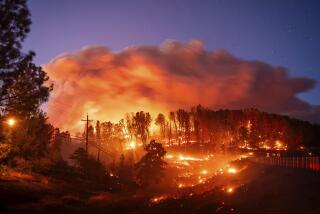Santa Barbara Mops Up; Bush Orders Disaster Aid
- Share via
SANTA BARBARA — Ground crews aided by helicopters and some welcome humidity encircled the disastrous Santa Barbara fire as it climbed slowly through dense brush in the Santa Ynez Mountains west of here Saturday, while in Maine President Bush ordered federal disaster help for Southern California.
Smoke was gone from the skies over Santa Barbara for the first time since Wednesday evening, when an arsonist used an incendiary device to unleash the destructive wildfire. Damage estimates had reached $237 million Saturday.
About 1,700 firefighters remained on hand, but the flames were moving away from the hamlet of Painted Cave--the last community threatened--toward an area west of Windy Gap.
As the name suggests, the canyons there are often windy, but cooler air and higher humidity were helping slow the advance.
“After a long battle, the fire has been contained,” Pat Kaunert, a U.S. Forest Service information officer, said at 8 p.m. Saturday. “A golden spike has been driven.”
Full control of the fire is expected Monday, he said.
Earlier, officials had predicted that crews would contain the fire by noon Saturday. But a thin finger of fire broke out of the northeast corner of the burn area and was stubbornly climbing through thick brush that had not burned in 50 years.
Firefighters with shovels and other tools were busy Saturday trying to clear the chaparral from the path of advancing flames, but the growth in the canyons was so dense that they had no place to put the tinder-dry brush they removed. They were counting on a firebreak already scraped into a ridge and the cooperation of the weather to stop the flames.
“We still have fire moving through the underbrush,” said Tom Rogers, chairman of the Santa Barbara County Board of Supervisors, who spoke at a briefing for news media. “It’s not something that is easily controlled. It could be a threat if the weather changes--we are watching the weather very closely.”
Elsewhere on the fire perimeter, which encircles 4,900 blackened acres, the fire is out except for isolated hot spots. The toll was set Saturday at 420 houses and 80 apartment units lost and another dozen houses damaged. The count has varied in daily briefings as official inspections are completed.
Meanwhile, fire crews began the hard, gritty work of mopping up.
Josh Cooper, a 20-year-old U.S. Forest Service firefighter from the Plumas National Forest in Northern California, said the crew worked 72 hours straight until getting their first sleep--six hours’ worth--Friday night.
Cooper said the crew was beginning to tire, in part because of the tediousness of the mop-up operation.
“You know you got to keep going,” he said, “but it ain’t anywhere near as rewarding as fighting a fire.”
Steve Graves, captain of the fire crew, said: “Mopping up is very tedious work, but it’s important.”
High in San Marcos Pass near Painted Cave, a crew of 14 state prisoners was dousing hot spots. Randy Wakefield, a prisoner from the California Men’s Colony in San Luis Obispo, said: “It’s hard work, but it’s rewarding.”
Wakefield, who is serving a six-year sentence for vehicular manslaughter, said the prisoner firefighters get $1 an hour and credit for one day served on their sentence for every day they are fighting a fire.
“The pressure is off now, but the work is not that different. We work as hard whether it’s burning or not,” Wakefield said.
In the San Marcos Trout Club area, where the fire began Wednesday afternoon, helicopters with dangling water tanks bombed smoldering brush as residents took stock of what remained of their life’s possessions.
Lois Brandts’ three-story house had looked down San Jose Canyon over Goleta to the ocean. Her house was gone--the most visible surviving hardware was two fire extinguishers--and the dozen California live oak trees that ringed the house were denuded and coated in an eerie gray film. The dogs, chickens, a collection of African art and four cars were lost to the fire.
“We always knew there was a danger,” Brandts said. “We knew we only leased the land from nature.” She said Trout Club was a special place to live; the people were friendly, and it was a real community.
“Even if I had known 17 years ago there was going to be a fire I still would have moved here,” she said. “Because every morning when I got up it was a privilege to be here.” Brandts had insurance, but Mary Morton did not. She was a renter in Trout Club and she said no company would cover her. She had escaped with her dogs but returned Saturday to search for her three cats. The house was gone. “It was a gamble for us,” she said. “Everything’s a total loss.”
Officials said Saturday that 16 investigators are engaged in the search for the arsonist. They asked anyone who was driving on San Marcos Pass Road on Wednesday between 5:30 and 6 p.m. to telephone the Santa Barbara County Fire Department. Residents were also asked to report any smoke they see this weekend to prevent a new outbreak.
Bush’s declaration of a disaster area clears the way for low-interest loans to homeowners and businesses and allows local officials to shift 75% of their costs to the federal government. Bush signed the declaration at his weekend retreat at Kennebunkport, Me.
Federal disaster aid will be made available to victims of the Santa Barbara County fire and last week’s arson-caused fire in Glendale, which claimed 46 homes.
Disaster relief also could be extended later to Riverside and San Diego counties, a federal official said Saturday. Last week’s wildfires in rugged, lightly populated areas there are virtually contained, firefighters said.
Equipment and firefighters were being released Saturday from the Riverside blaze, southeast of Corona, and containment was expected by 6 p.m. today. That fire spread from a controlled burn June 19.
The San Diego fire, near the community of San Felipe, was set by an arsonist and was reported 90% contained Saturday after burning four structures but no homes.
For victims of the Santa Barbara and Glendale fires who are eligible for aid, the federal loans are limited to $100,000 for homes and $500,000 for businesses. The $100,000 limit on residential losses was set by a federal statute that was last updated in 1988, a spokesman for the Federal Emergency Management Agency said.
“We sure understand that $100,000 is far short of actual losses,” spokesman Carl Suchocki said. He noted, however, that the loans are designed to cover only the portion of losses not covered by homeowners insurance.
Additional loans of up to $20,000 are available to cover uninsured loss of personal property. Suchocki said interest on the loans would be in the range of 4% to 8%, considerably below prevailing market rates.
The federal disaster relief program also provides up to 18 months of rent reimbursement for temporary housing and payments up to $10,400 to cover other disaster-related needs, such as uninsured medical expenses and emergency transportation. The money comes from a disaster relief fund already appropriated by Congress.
A center for displaced Santa Barbara County residents to apply for aid opened at the county school auditorium on Cathedral Oaks Road. Business people in Goleta also opened a recovery information center at the Goleta Youth Sports Center on Saturday. Officials from banks, utility companies, contractors, county building officials and insurance brokers were stationed at booths to answer questions.
“The idea was hatched at 9 (a.m.) yesterday and we opened today at eight,” Steve Amerikaner, a bank executive, said Saturday.
The Santa Barbara area is under the most severe drought restrictions in the state because of low reservoir levels. Officials said Saturday that the fire consumed 300 acre-feet of water, about the amount typically used in three or four days.
Roderick reported from Los Angeles, Paddock from Santa Barbara. Contributing to this report were Oswald Johnston in Washington and Ashley Dunn in Santa Barbara.
Stricken families in Santa Barbara on the road back: A45
More to Read
Sign up for Essential California
The most important California stories and recommendations in your inbox every morning.
You may occasionally receive promotional content from the Los Angeles Times.










